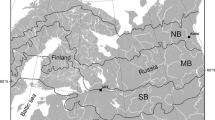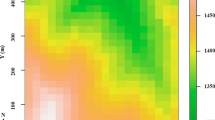Abstract
To maintain biodiversity in managed, boreal forest in Scandinavia, aspen trees (Populus tremula) are often retained at clearcutting. In this study, the habitat availability for beetles associated with aspen coarse woody debris (CWD) was predicted for forests and clearcuts with a model of CWD dynamics. Habitat requirements of eight beetle species (Agathidium bicolor, Cerylon ferrugineum, Cyphaea curtula, Endomychus coccineus, Homalota plana, Mycetophagus fulvicollis, Ptilinus fuscus and Xylotrechus rusticus) were obtained from their occurrence patterns in relation to characteristics of CWD objects in forest and on clearcuts in a study landscape in central Sweden. Three species were more frequent in forest and three at clearcuts. Five species increased with increasing girth of the CWD. Three were more frequent on standing CWD, and two on lying CWD. From the same study area, we also obtained field data on the recruitment of CWD (i.e., tree mortality) and amounts of different types of CWD. Annual tree mortality of aspen was higher for recent clearcuts (6.3%) compared with older clearcuts (1.1%). For all species, the habitat availability was higher on clearcuts, because enhanced tree mortality increased the amount of recently dead CWD. As a conclusion, green-tree retention of aspen is a conservation effort that is beneficial for species associated with aspen CWD.



Similar content being viewed by others
Abbreviations
- CWD:
-
Coarse woody debris
- NT:
-
Near threatened, red list category
- LC:
-
Least concern, red list category
- FSC:
-
Forest stewardship council
References
Ahti T, Hämet-Ahti L, Jalas J (1968) Vegetation zones and their sections in Northwestern Europe. Ann Bot Fenn 5:169–211
Anonymous (2000) Svensk FSC-standard för certifiering av skogsbruk. Svenska FSC-Rådet, Uppsala
Dahlberg A, Stokland JN (2004) Vedlevande arters krav på substrat. Rapport No. 7. Skogsstyrelsen, Jönköping
Edenius L, Ericsson G (2007) Aspen demographics in relation to spatial context and ungulate browsing: implications for conservation and forest management. Biol Conserv 135:293–301. doi:10.1016/j.biocon.2006.10.052
Edgren V, Nylinder P (1949) Funktioner och tabeller för bestämning av avsmalning och formkvot under bark för tall och gran i norra och södra Sverige. Meddelanden från Statens skogsforskningsinstitut 38, Stockholm
Ericsson G, Edenius L, Sundström D (2001) Factors affecting browsing by moose (Alces alces L.) on European aspen (Populus tremula L.) in a managed boreal landscape. Écoscience 8:344–349
Eriksson H (1973) Volymfunktioner för stående träd av ask, asp, klibbal och contorta-tall. Rapporter och uppsatser 26. Institutionen för skogsproduktion, Skogshögskolan, Stockholm
Esseen P-A (1994) Tree mortality patterns after experimental fragmentation of an old-growth conifer forest. Biol Conserv 68:19–28. doi:10.1016/0006-3207(94)90542-8
Esseen P-A, Ehnström B, Ericson L, Sjöberg K (1997) Boreal forests—the focal habitats of Fennoscandia. Ecol Bull 46:16–47
Gärdenfors U (2000) Hur rödlistas arter? Manual och riktlinjer (How to red-list species. Manual and guidelines). ArtDatabanken, SLU, Uppsala (In Swedish, English summary)
Gärdenfors U (ed) (2005) The 2005 red list of Swedish species. ArtDatabanken, SLU, Uppsala
Grove SJ (2002) Saproxylic insect ecology and the sustainable management of forests. Annu Rev Ecol Syst 33:1–23. doi:10.1146/annurev.ecolsys.33.010802.150507
Harmon ME, Franklin JF, Swanson FJ, Sollins P, Gregory SV, Lattin JD, Anderson NH, Cline SP, Aumen NG, Sedell JR, Lienkaemper GW, Cromack K Jr, Cummins KW (1986) Ecology of coarse woody debris in temperate ecosystems. Adv Ecol Res 15:133–302. doi:10.1016/S0065-2504(08)60121-X
Hautala H, Jalonen J, Laaka-Lindberg S, Vanha-Majamaa I (2004) Impacts of retention felling on coarse woody debris (CWD) in mature boreal spruce forests in Finland. Biodivers Conserv 13:1541–1554. doi:10.1023/B:BIOC.0000021327.43783.a9
Hedenås H, Ericson L (2004) Aspen lichens in agricultural and forest landscapes: the importance of habitat quality. Ecography 27:521–531. doi:10.1111/j.0906-7590.2004.03866.x
Hylander K, Jonsson BG (2007) The conservation ecology of cryptogams. Biol Conserv 135:311–314. doi:10.1016/j.biocon.2006.10.019
Jonsell M, Weslien J (2003) Felled or standing retained wood—it makes a difference for saproxylic beetles. For Ecol Manag 175:425–435. doi:10.1016/S0378-1127(02)00143-3
Jonsell M, Nittérus K, Stighäll K (2004) Saproxylic beetles in natural and man-made deciduous high stumps retained for conservation. Biol Conserv 118:163–173. doi:10.1016/j.biocon.2003.08.017
Jonsson BG, Kruys N, Ranius T (2005) Ecology of species living on dead wood—lessons for dead wood management. Silva Fenn 39:289–309
Jönsson MT, Fraver S, Jonsson BG, Dynesius M, Rydgård M, Esseen PA (2007) Eighteen years of tree mortality and structural change in an experimentally fragmented Norway spruce forest. For Ecol Manag 242:306–313
Koch K (1989a) Die Käfer Mitteleuropas—Ökologie 1. Goecke & Evers Verlag, Krefeld
Koch K (1989b) Die Käfer Mitteleuropas—Ökologie 2. Goecke & Evers Verlag, Krefeld
Kouki J, Löfman S, Martikainen P, Rouvinen S, Uotila A (2001) Forest fragmentation in Fennoscandia: linking habitat requirements of wood-associated threatened species to landscape and habitat changes. Scand J For Res Suppl 3:27–37. doi:10.1080/028275801300090564
Larsson S, Danell K (2001) Science and the management of boreal forest diversity. Scand J For Res Suppl 3:5–9. doi:10.1080/028275801300090528
Linder P, Östlund L (1998) Structural changes in three mid-boreal Swedish forest landscapes, 1885–1996. Biol Conserv 85:9–19. doi:10.1016/S0006-3207(97)00168-7
Lindhe A, Lindelöw Å, Åsenblad N (2005) Saproxylic beetles in standing dead wood density in relation to substrate sun-exposure and diameter. Biodivers Conserv 14:3033–3053. doi:10.1007/s10531-004-0314-y
Martikainen P (2001) Conservation of threatened saproxylic beetles: significance of retained aspen Populus tremula on clearcut areas. Ecol Bull 49:205–218
New TR (1998) Invertebrate surveys for conservation. Oxford University Press, Oxford
Östlund L (1993) Exploitation and structural changes in the north Swedish boreal forest 1800–1992. Dissertation, Swedish University of Agricultural Sciences, Department of Forest Vegetation Ecology, Umeå
Östlund L, Zackrisson O, Axelsson AL (1997) The history and transformation of a Scandinavian boreal forest landscape since the 19th century. Can J For Res 27:1198–1206
Ozolincius R, Miksys V, Stakenas V (2005) Growth-independent mortality of Lithuanian forest tree species. Scand J For Res 20:153–160. doi:10.1080/14004080510042164
Palm T (1959) Die Holz- und Rindenkäfer der Süd- und Mittelschwedischen Laubbäume. Opuscula Entomologica Supplementum XVI, Lund
Ranius T, Kindvall O (2004) Modelling the amount of coarse woody debris produced by the new biodiversity-oriented silvicultural practices in Sweden. Biol Conserv 119:51–59. doi:10.1016/j.biocon.2003.10.021
Rosenvald R, Lõhmus A, Kiviste A (2008) Preadaptation and spatial effects on retention-tree survival in cut areas in Estonia. Can J For Res 38:2616–2625. doi:10.1139/X08-093
Schroeder LM, Ranius T, Ekbom B, Larsson S (2006) Recruitment of saproxylic beetles in high stumps created for maintaining biodiversity in a boreal forest landscape. Can J For Res 36:2168–2178. doi:10.1139/X06-119
Siitonen J (2001) Forest management, coarse woody debris and saproxylic organisms: Fennoscandian boreal forests as an example. Ecol Bull 49:11–41
Siitonen J, Martikainen P (1994) Occurrence of rare and threatened insects living on decaying Populus tremula—a comparison between Finnish and Russian Karelia. Scand J For Res 9:185–191
Siitonen J, Saaristo L (2000) Habitat requirements and conservation of Pytho kolwensis, a beetle species of old-growth boreal forest. Biol Conserv 94:211–220. doi:10.1016/S0006-3207(99)00174-3
Sverdrup-Thygeson A, Ims RA (2002) The effect of forest clearcutting in Norway on the community of saproxylic beetles on aspen. Biol Conserv 106:347–357. doi:10.1016/S0006-3207(01)00261-0
Tikkanen OP, Martikainen P, Hyvärinen E, Junninen K, Kouki J (2006) Red-listed boreal forest species of Finland: associations with forest structure, tree species, and decaying wood. Ann Zool Fenn 43:373–383
Trägårdh I (1939) Sveriges skogsinsekter, 2nd edn. Stockholm
Wikars LO, Sahlin E, Ranius T (2005) A comparison of three methods to estimate species richness of saproxylic beetles (Coleoptera) in logs and high stumps of Norway spruce. Can Entomol 137:304–324
Acknowledgments
Barbara Ekbom, Martin Schroeder, Lars-Ove Wikars and Ola Kårén provided valuable comments on the manuscript. Support for this study came from the projects ‘Conservation of Biodiversity in Managed Forests’ (grants to Stig Larsson and Kjell Danell) financed by the Faculty of Forestry at The Swedish University of Agricultural Sciences (SLU) and ‘Predicting Extinction Risks for Threatened Wood-living Insects in Dynamic Landscapes’ (grant to Thomas Ranius) financed by The Swedish Research Council for Environment, Agricultural Sciences and Spatial Planning (FORMAS). Holmen Skog AB generously provided maps, aerial photographs and hosted our field study.
Author information
Authors and Affiliations
Corresponding author
Rights and permissions
About this article
Cite this article
Sahlin, E., Ranius, T. Habitat availability in forests and clearcuts for saproxylic beetles associated with aspen. Biodivers Conserv 18, 621–638 (2009). https://doi.org/10.1007/s10531-008-9528-8
Received:
Accepted:
Published:
Issue Date:
DOI: https://doi.org/10.1007/s10531-008-9528-8




